Abstract
Here, we investigated the wood-whitening phenomenon adjacent to metal components that are commonly observed in Japanese historic architectures. The higher detection of Cu/Zn elements and fine particles of copper/zinc oxalate hydrate in whitened wood has been verified in a previous field investigation. In order to explore the related cause of this phenomenon, this study established model experiments to evaluate some surface performance changes of wood plate samples with impregnated Cu(II)/Zn(II) contents under artificial degradation. The evaluation included the following: (1) the state of metal oxalates in the wood tissue; (2) the mechanical performance of the resistance to the external forces; and (3) the colour change of the wood surface. As the result, the accumulation of metal oxalates and their growth in particle sizes were confirmed in samples containing metal, in particular those with a higher Cu(II) content, regardless of wood species. Meanwhile, this metal-involved degradation could introduce the risk of embrittlement of wood ahead of the occurrence of visible whitening discolouration.
1. Introduction
Wood whitening is a phenomenon commonly observed in historic wooden architectures or constructions. In the case of Japanese historic architectures, this phenomenon can usually be observed on wood adjacent to distinctive decorative metallic components made of gold, silver, copper, iron, tin and their alloys. Figure 1 presents several examples from historic architectures around Japan, including the World Heritages, National Treasures and Important Cultural Properties of Japan. In a previous work, the authors were permitted to conduct a field investigation on the whitening wood adjacent to Cu and Cu–Zn alloy components in the Old Iwasaki-ke Suehiro-bettei Villa, Tomisato City, Chiba Prefecture, Japan. The Old Iwasaki-ke Suehiro-bettei Villa was constructed by Iwasaki Hisaya, the third commander of Mitsubishi Zaibatsu, to develop the agricultural industry in Tomisato areas at the beginning of the Showa period (1920s–1930s). As a reflection of the upper-class lifestyle at the beginning of the Showa period, the site was registered as Registration Tangible Cultural Properties of Japan in 2013. Along with the promotion of the preservation and social utilisation project for this site in recent years, proper conservation strategies to deal with the deterioration phenomena occurring on the historic architecture are urgently required. Scientific and comprehensive understandings toward each type of degradation phenomenon are the basis for making proper conservation strategies of long-term preservation [1].
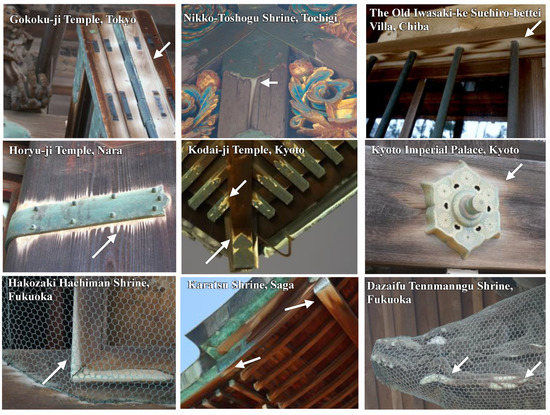
Figure 1.
The whitening phenomenon of wood adjacent to metal components (white arrows pointing to the area) can be seen in the case of Japanese historic architectures. Reproduced with permission from ref [2]. 2021 Taylor & Francis.
The results of the authors’ previous field investigation indicated the presence of significant Cu/Zn elements and fine particles identified as copper/zinc oxalate hydrate particles in the whitening wood (Figure 2) [3,4]. These findings suggest a new possible cause that may lead to the whitening discolouration of the wood, in addition to white-rot fungi [5], UV light and visible irradiation [6,7] and calcareous depositions from the contacted ground [3,8], which have been more profoundly studied. To verify the processes of how metal ions affect wood and ultimately result in the generation of metal oxalates, a model experiment was carried out by authors with wood powders of Sugi (Cryptomeria japonica) and Keyaki (Zelkova serrata), with different levels of the Cu(II)/Zn(II) ion content (percentage of dry weight: 0.00%, 0.05%, 0.50% and 2.50%), exposed to 60 °C and a relative humidity (RH) of 90% in a previous work. The analysis of the degraded samples proved that there were a significant proportion of oxalate ions and monosaccharides and the generation of metal oxalates, especially in the cases with a 2.50% Cu(II) content [2]. Accordingly, it is supposed that metal ions such as Cu(II) may play a role as an active donator or acceptor of electrons in promoting the generation of hydroxyl radicals and some other oxidizing agents with the participation of oxygen. Under the attack from those oxidizing agents, the polysaccharides of wood cell wall structural constituents decomposed [9,10], resulting in the production of oxalic acid, which then combined with metal ions to form metal oxalate precipitate on wood tissues.

Figure 2.
The investigation results of whitening points adjacent to Cu–Zn window bars in the Old Iwasaki-ke Suehiro-bettei. (a) The investigated area. (b) The colour parameters of the investigated whitening points and the corresponding reference points. The analysis results of the whitening point 5-1: (c) the scanning electron microscopy back-scattered electron (SEM-BSE) image, with scattered fine particles among tracheid (Tr) shown to have a significant Zn content; (d) the Fourier-transform infrared (FTIR) spectrum, shown with C2O4-related bands (●: 1630, 1363, 1317 and 822 cm−1) and Zn–O-related bands (○: 510–400 cm−1); (e) the XRD spectrum, shown with the characteristic peaks of zinc oxalate hydrate. Reproduced with permission from ref. [2]. 2021 Taylor & Francis.
The above-mentioned studies have provided a plausible explanation of this whitening phenomenon as a result of some internal decompositions of wood cell wall constituents. This implicates the risk of mechanical performance degradation, endangering the strength of wooden components. However, these concerns have not been proven yet.
In order to find a potential answer to concerns for long-term conservation, this study launched an experiment to evaluate some surface performance changes of artificially degraded wood plate samples with Cu(II)/Zn(II) contents. The evaluation results of the following aspects were reported in this paper: (1) the state of metal oxalates in the wood tissue; (2) the mechanical performance of the resistance to external forces; (3) the colour change of the wood surface.
2. Materials and Methods
2.1. Sample Preparation and Exposure Conditions for Artificial Degradation
Healthy, fresh, knotless and plain sawn sapwood of Sugi (Cryptomeria japonica) and Keyaki (Zelkova serrata), which are the typical softwood and hardwood species used in historic wooden architectures in Japan, respectively [11], were prepared into two types with different evaluation methods: A-type (5 mm (R) by 10 mm (T) by 150 mm (L)) and B-type (4 mm (R) by 20 mm (T) by 10 mm (L)), where R indicates the radical direction, T indicates the tangential direction, and L indicates the longitudinal direction. Wood plates with even earlywood in tangential sections and parallel grain in radical sections were selected to minimise the local differences of each sample.
The wood plates were then submerged in three levels of CuCl2/ZnCl2 solutions separately for 7 days and naturally dried. After impregnation, the metal content of Cu(II)/Zn(II) in each sample was quantified through ion chromatography (IC) analysis with water extraction prepared from pad saw-scratched wood powder (particle size: 177–250 mm). Wood powder (~10 mg) was soaked in 10 mL ultra-pure water (JIS A4 water standard) for 48 h and then filtered with a syringe filter (0.45 mm pore size, regenerated cellulose-membrane; Minisart, Satorius, Goettingen, Germany). Cation analysis was carried out using a Methrohm 883 Basic IC Plus (883 Basic IC plus, Methrohm, Riverview, FL, USA) with a METROSEP C3 25/4.0 (6.1010.430) column, a mixed eluent solution of 5.0 mM HNO3 and 0.5 mM H2C2O4, a 1.0 mL/min flow rate and a 15 min running time. Peak areas were calculated with MagIC Net (version 3.1) software for quantification analysis. The results were expressed as a percentage in the weight of the ion content to the wood powder dried weight (wt %: mg/mg).
According to the results of the preliminary experiments, the Keyaki plate had a lower absorption capacity for metal ions than the Sugi plate. To ensure that the metal content levels of Keyaki and Sugi samples were not overly dissimilar and affected the comparability of the results, for the Sugi group samples, the concentration of the impregnation solution was prepared at 100, 1000 and 10,000 ppm, while in the case of Keyaki group, 2 times the amounts of the corresponding concentrations were applied. The quantification of Cu(II)/Zn(II) ion contents in the impregnated samples is summarized in Table 1. No-impregnation-treated blank wood plates were set as the control groups. For each sample, 3 specimens were prepared.

Table 1.
The metal ion contents in the wood plate samples after impregnation.
From a literature survey, high humidity was applied as the artificial degradation condition in studies of degradation in iron-contaminated archaeological wood. Under this condition, the correlations between the O2 consumption, degradation of hemicellulose fractions, reduction in tensile strength, formation of oxalic acid and formation of CO2 have been verified [12,13,14]. In this study, the prepared wood plate samples were exposed at 60 °C and an RH of 90%, conditioned by a constant climate cabinet (SH-221, ESPEC, Hudsonville, MI, USA), and the samples were evaluated every 30 days.
2.2. Evaluation Methods
2.2.1. Confirmation of the Generation of Metal Oxalates on the Wood Surface
- Fourier-Transform Infrared Attenuated Total Reflection (FTIR-ATR) Analysis
The continuous changes in metal oxalates on the wood surface were confirmed by FTIR-ATR analysis focusing on the same point of one sample surface. The three specimens of each A-type sample were analysed every 30 days. The analysis and spectra processing were performed with a spectrometer with Spectrum One (B) and Spectrum v3.00 software (PerkinElmer, Waltham, MA, USA). The analysis conditions were the room temperature, standard pressure, 4000–400 cm−1 range, 4 cm−1 resolution, and 64-averaged scans. The spectra were smoothed using a 9-point block-averaging method, then baseline-corrected manually with a set of baseline through points at 1800, 1773, 1496, 834 and 400 cm−1 and normalized with a set of 1800 cm−1 as 0 and the maximum band at 1030 cm−1 as 1.
- Scanning Electron Microscopy Equipped with an Electron Probe Micro-Analyser (SEM-EPMA) Analysis
The state of newly generated metal oxalate particles in wood tissue was observed by SEM-EPMA. Considering that the coating treatment for SEM observation would change the surface colours of the samples, a carbon-tape sampling method was performed in this study. In this way, the state changes of metal oxalate could be continuously observed while ensuring colorimetric measurements were not affected at different exposure stages. The carbon tapes sized at ~10 × 10 mm2 were gently attached to the surfaces of B-type samples and then peeled off to be carbon-coated.
A JXA-8530F Electron Probe Micro Analyzer (JEOL, Tokyo, Japan) was applied with conditions of the following: a 15 kV voltage, a 2 mm beam diameter, a 50 nA current for the EPMA qualitative analysis and a 10 nA current for the observation and EPMA mapping analysis. The detectable element range was B–U. To avoid the interference of carbon-coating and light elements contained in the wood tissue with the results of elemental qualitative analysis, the Ne element and elements with a lower atomic number were filtered out.
Images obtained with a back-scattered electron detector were used to distinguish wooden and inorganic materials through the image contrast (brighter tones representing greater average atomic numbers). The distributions of elements are shown as the distributions of colours in EPMA maps by specifying the colours and the corresponding elements.
2.2.2. Mechanical Tests
In this study, the mechanical performance of the resistance to external forces was considered. Less- or non-destructive static and dynamic methods were applied to track the changes.
- Static Method
In common indentation hardness testing methods, hardness is determined by the depth of permanent indentation produced in the test material by applying a certain force to a specific indenter [15]. The displacement of materials proportionately increases with the force, until it exceeds a certain limit, known as the elastic limit. It is assumed that the displacement will not become a permanent indentation and will be regained upon release from the force, if the force is not beyond the elastic limit. The greater the resistance to external forces, the steeper or higher the slope of the linear region in the force–displacement diagram should be [16].
Thus, a less destructive compression test perpendicular to the grain on the tangential section was designed by applying the slope of the linear region of the force–displacement diagrams to represent the surface hardness change of degraded wood (Figure 3). The B-type plate samples were tested using a universal testing machine (STA-1225, ORIENTEC CORP., Saitama, Japan) in the concentrated point-loading mode, with a spherical top steel presser (diameter: 11 mm) and a load rate of 0.5 mm/minute. The loading process was stopped, after the displacement reached 1 mm in each test. Then, linear regression was performed to obtain the slope of the force–displacement diagram.
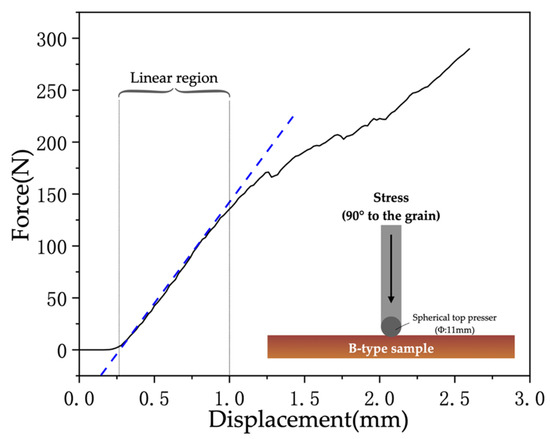
Figure 3.
The compression test perpendicular to grain using the concentrated point loading mode and an example of the stress–strain diagram.
- Dynamic Method
The modulus of elasticity (MOE) is one key parameter for evaluating the rigidity of wood, which could be obtained through dynamic non-destructive methods, for instance, the commonly applied resonance frequency techniques. The MOEs determined by dynamic methods were proved to be statically linearly related to those calculated from conventional static tests [17,18].
In this study, a free-free flexural vibration test was conducted to evaluate the A-type samples. The measuring apparatus is illustrated in Figure 4. “Free-free” refers to supporting a wood plate sample with two cotton threads located at 22.42% and 77.58% of the sample’s length. Two thin iron plates (3 × 10 mm2) were attached to two ends of one sample on the opposite sides. The sample was vibrated by a magnetic driver, and the amplitude of vibration was detected by an eddy-current sensor. The detected signals were transferred through a bandpass filter and then visualized by a Fast Fourier Transform (FFT) analyser; the frequency with the highest amplitude value was determined and set as the central value. The corresponding amplitude values of a series of frequencies around the central value were recorded. The curves of the recorded frequencies and the corresponding amplitude values were approximated with the theoretical equation for a viscoelastic solid to determine the resonance frequency and the tanδ (also referred to as the mechanical loss tangent) [19,20]. The MOE (E′) of the sample was calculated according to Equation (1):
where l, f, 𝜌 and h are the length, resonance frequency, density and thickness of the sample, respectively, and mn is the constant corresponding to the mode of the test, which equalled to 4.73 in the case of free-free flexural vibration.

Figure 4.
The measuring apparatus of the flexural vibration test.
2.2.3. Colorimetric Measurements
Superficial colour change was evaluated by taking the colorimetric measurements of the B-type wood plate samples using a spectrophotometer (NF333, Nippon Denshoku Industries, JPN) in the reflectance measurement mode under the conditions of D65 Illuminant, a 10° observer angle and the 3-flash-averaging mode. The colour was numerically reflected using the 1976 CIE L*a*b* colorimetric system, in which the whiteness is represented by the L* value, from 0 (black) to 100 (white), while a* and b* represent redness(+)–greenness(-) and yellowness(+)–blueness(-), respectively [21].
3. Results
3.1. Detection of Metal Oxalates
The spectral changes were most noticeably presented in the cases of S/K-A-Cu 3 after a 90-day exposure (Figure 5). The appearance of new bands at 1607, 1360, 1317, 822 and 498 cm−1 shown in the spectra of S/K-A-Cu 3 were assigned to copper oxalate (Table 2) [3,22,23]. The absorbance of the band at 822 cm−1 was generated from the symmetric C=O stretching belonging to the oxalate functional group, which had a less overlapping with characteristic bands belonging to wood chemical constituents [24]. It was selected to present the changes in the oxalate-related band at different exposure stages.

Figure 5.
FTIR spectra for (a) S-A-Cu 3/Zn 3/0 and (b) K-A-Cu 3/Zn 3/0 after 0/90-day exposures.

Table 2.
Wood cell wall structural constituents, metal oxalate and assignment of FTIR characteristic bands.
The average changes and standard deviations in the absorbance at 822 cm−1 with the unexposed samples are presented as a percentage in Figure 6. The increase in the absorbance at 822 cm−1 with the exposure day could be observed in most of the Sugi and Keyaki samples with Cu(II) contents, and the more Cu(II) the samples contained, the more significant the increase. The K-A-Cu 3 showed the most rapid increase ultimately as a dramatic higher average change after a 90 d exposure (40,432.5%). The samples with Zn(II) appeared less pronounced. For instance, the Sugi groups and most Keyaki groups showed few differences with the blank samples, regardless of the Zn(II) content level. The increase could only be observed in the case of K-A-Zn 3.
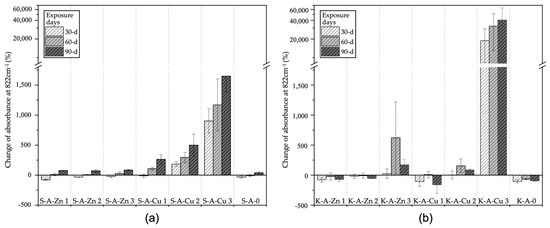
Figure 6.
The average change in absorbances at 822 cm−1 with the exposure day: (a) Sugi samples; and (b) Keyaki samples (n = 3).
3.2. Particles in Wood Tissues
Before the exposure, only wood tissues with a dark grey tone could be observed in the BSE images for all samples, regardless of metal contents or wood species (Figure 7a). Additional particles with brighter tones were observed, which were scattered in the wood tissues in samples with a higher Cu(II) content from 30 days of exposure onward. However, these were not seen in most samples with Zn(II) and lower-level Cu(II) contents. The SEM-BSE images of the samples with higher Zn(II) and Cu(II) contents are shown in Figure 7b,c. In the case of S-B-Cu 3, the particles were mostly attached to the edges of the tracheid. In the case of K-B-Cu 3, the particles were scattered in the overall image, which even appeared to be quite similar to the BSE image for the whitened wood of the Old Iwasaki-ke Suehiro-bettei Villa shown in Figure 2a.
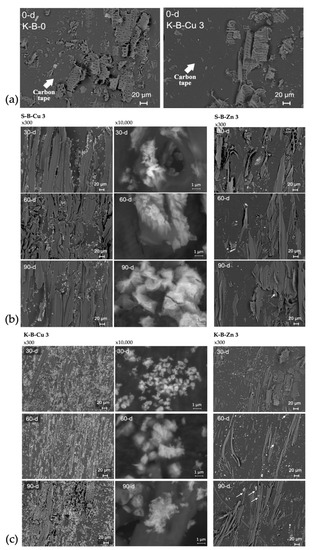
Figure 7.
The SEM-BSE images of unexposed K-B-0/K-B-Cu 3 (a), exposed S-B-Cu 3 (300× and 1000×), S-B-Zn 3 (300×) (b), exposed K-B-Cu 3 (300× and 1000×) and K-B-Zn 3 (300×) (c). The white arrows point to the scattered particles among wood tissues in the samples with Zn contents.
In the 10,000× magnification images of S/K-B-Cu 3 at different exposure stages, the particles appeared as aggregations of flake-like crystals, and changes in aggregation sizes with exposure days could be recognised (Figure 7b,c). For S-B-Cu 3, the aggregation sizes of flake-like crystals grew from <1 μm to around or greater than 1 μm and then to around 2 μm. For K-B-Cu 3, scattering particles changed from fine particles sized around 0.5 μm to small aggregations of flake-like crystals sized around 1 μm and then to larger aggregations sized around 5 μm. In comparison, a greater quantity of fine particles with larger sizes is presented in Figure 2a. Some of the particles are shown as rosette-like aggregations with sizes around 10 μm.
3.3. Distribution of Elements
It was not clear whether the occurrence of particles is due to the precipitation of the artificially introduced solute or the generation of metal oxalate confirmed in FTIR analysis for A-type samples.
Scattered brighter particles were analysed using EPMA qualitative elemental analysis for the 90-day-exposed K-B-Cu 3 and S-B-Zn 3. The particles of K-B-Cu 3 predominately consisted of Cu, with minor Si and Cl. For the S-B-Zn 3, this predominately consisted of Zn with a low atom percentage of Cl. Si was a common element in wood tissues, and Zn, Cu and Cl were artificially impregnated into the wood tissues (Figure 8).

Figure 8.
The qualitative analysis of scattered particles in the 90-day-exposed S-B-Zn 3 (a) and K-B-Cu 3 (b).
Based on the results of the qualitative elemental analysis, the EPMA mapping analysis was performed, focusing on the distributions of Zn, Cu and Cl. It is noteworthy that the distributions of Cu and Cl at 0 days of exposure to K-B-Cu 3 coincided with the vessels of wood tissues, whereas in the EPMA maps of the 30-day-exposed S/K-B-Cu 3 the distributions of Cl coincided with wood tissues and the distributions of Cu mostly coincided with the scattered particles. The observed particles were much fewer in the images of 30-day-exposed S/K-B-Zn 3, while it is interesting to note that the inconsistent distributions of Zn and Cl are present in the image of K-B-Zn 3 (Figure 9).
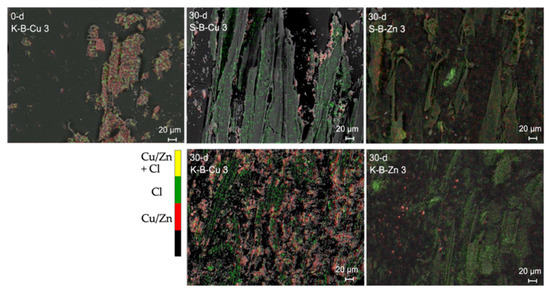
Figure 9.
The BSE images combined with the electron probe micro-analyser (EPMA) maps of the 0-day-exposed K-B-Cu 3 and 30-day exposed S-B-Cu/Zn 3 and K-B-Cu/Zn 3.
Before exposure, both metal and Cl elements were predominantly present in the wood tissue, while as the exposure proceeded, the metal elements in wood tissues migrated out to form particles. The inconsistency in the distribution of Cl and metal elements implied that the predominant elemental compositions of the newly appearing particles during the exposure process were metal elements other than Cl. Lighter elements (O and C), which were not detectable with the EPMA, could be contained. Thus, it is possible that these bright particle aggregates were copper oxalate compounds as suggested by the bands in the FTIR spectra.
3.4. Mechanical Performances
The average changes and standard deviations in the slope of the force–displacement diagram, E′, and tanδ obtained by a flexural vibration test after 120 days of exposure with respect to the unexposed samples are shown as percentages in Figure 10.
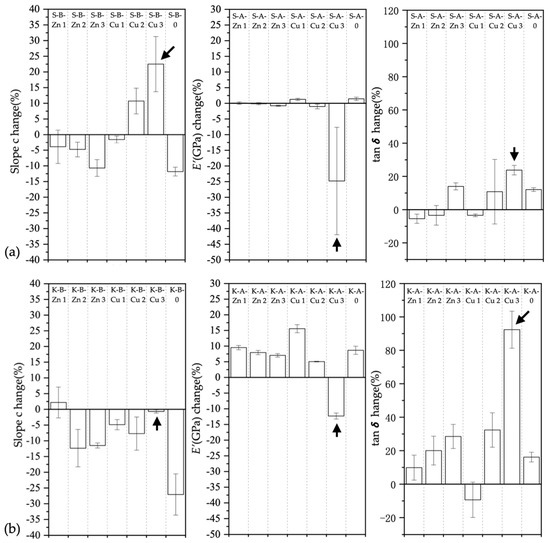
Figure 10.
The average changes in the slope of the force–displacement diagram, E′, and tanδ obtained by a flexural vibration test after 120 days of exposure with respect to the unexposed samples: (a) Sugi groups; (b) Keyaki groups (n = 3). The high Cu(II)-containing S/K-B-Cu 3 showed significantly distinct performances (pointed by black arrows).
The negative changes in the slope were seen in most samples and their dependences on the metal content were hardly recognised, whereas in the case of Sugi samples containing Cu(II) contents, the slope changes were positive and increased with the Cu(II) content.
In contrast, the differences in the results of the flexural vibration test between the blank and metal-containing samples were significantly distinct. The changes in the E′ of the degraded blank samples were positive. For Sugi groups containing metal contents, the changes in E′ were negative and became significant with increases in the metal content, although this was less noticeable in the case of those containing Zn(II). The average change in S-A-Cu 3 was −24.8%, the average change in S-A-Zn 3 was −0.8%, and the average change in S-A-0 was 1.5%. For Keyaki groups, in the samples containing Zn(II), the changes in E′ were positive, while decreases were observed with the Zn(II) content; in the samples containing Cu(II), the positive changes in E′ shifted to the negative with the increase in the Cu(II) content. The average change in K-A-Cu 3 was −12.3%, the average change in K-A-Zn 3 was 7.0%, and the average change in K-A-0 was 8.7%.
The changes in tanδ of the degraded blank samples were also positive. For Sugi groups containing metal contents, the unnoticeable negative changes in tanδ shifted to the positive with increases in metal contents. The S-A-Cu 3 showed the highest change of 23.8%. The average change in S-A-Zn 3 was 14.0%, and the average change in S-A-0 was 12.1%. For Keyaki groups, in the samples containing Zn(II), the changes in tanδ were positive and increased with the Zn(II) content; in the samples containing Cu(II), the insignificant negative change in tanδ in K-A-Cu 1 shifted to the positive with the increase in the Cu(II) content, and a dramatic higher value of 92.4% in K-A-Cu 3 was shown. The average change in K-A-Zn 3 was 28.5%, and the average change in K-A-0 was 16.2%.
3.5. Colour Change
The average changes and standard deviations in colour parameters with the unexposed samples are presented as percentages in Figure 11. In the 1976 CIE L*a*b* system, the whitening discolouration can be expressed as a rise in L* to 100 and a tendency to 0 in a* and b*. As shown in Figure 2b, the whitening points present a significantly higher L*, a slightly lower a* (with positive and low values), and a similar b* in comparison with the reference points. According to this, the whitening discolouration was not confirmed after 120 days of exposure in this study, even for S-B-Cu 3 and K-B-Cu 3 samples in which significant copper oxalate particles were detected by FTIR and SEM-EPMA analysis. The S-B-Cu 3 presented higher colour parameters L*, a* and b*, indicating a brighter reddish discolouration, while the K-B-Cu 3 presented an almost constant L* value and lower a* and b* values, indicating a greyish discoloration. Neither can be seen as whitening.
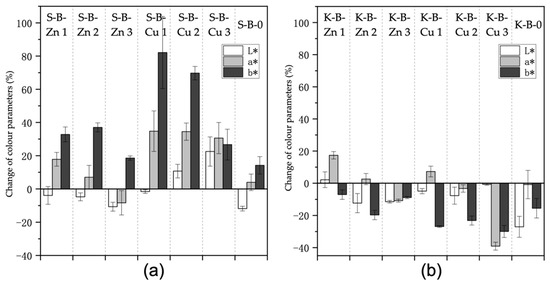
Figure 11.
The change in colour parameters values of 120-day-exposed samples: (a) Sugi groups; (b) Keyaki groups (n = 3).
Nonetheless, the three colour parameters L*, a* and b* for the samples containing metal and the blank samples showed different variations. For Sugi groups, the 120-day-exposed blank sample S-B-0 presented a negative change in L* and positive changes in a* and b*. The samples containing Zn(II) showed similar changes. In samples containing Cu(II), the a* and b* parameters changes were positive and decreased with the increase in the Cu(II) concentration, whereas the L* changes increased. In the case of S-B-Cu 3, the average change in L* was the highest (22.4%), and the changes in a* and b* were less significant with respect to S-B-Cu 2/1 (Figure 11a). For Keyaki groups, the blank sample K-B-0 showed negative changes in L* and b* and a constant a* value. Except for K-B-Cu 3, the other samples containing metal showed less significant changes, and their dependences on the metal contents were hardly observed. In the case of K-B-Cu 3, it is noteworthy that changes in L* were extremely unnoticeable (−0.7%), while they were quite substantial in a* and b*, with respect to K-B-0 (Figure 11b).
4. Discussion
4.1. Mechanical Performance of Wood under the Effect from Cu(II)
The flexural vibration test revealed the most significant changes, i.e., decreased E′ and increased tanδ, in the case of samples containing higher Cu(II) contents, regardless of wood species. The E′ value determined by the flexural vibration test was sensitive to the degradation of the wood surface. It reflected the rigidity of the wood cell wall, which was predominantly determined by the volume fraction of rigid crystalline cellulose and the rigidity of the amorphous matrix polymers. The tanδ value of wood reflected the volume fraction and viscoelastic properties of the amorphous matrix polymers. Accordingly, the decrease in E′ and the increase in tanδ indicated the enhancement in the mobility of matrix polymers (such as hemicelluloses), resulting from their depolymerization. Besides, the increase in tanδ could also be attributed to the introduction of low-molecular-weight plasticizers, such as water and sugars [25].
In the authors’ previous works, it was confirmed that Zn(II)/Cu(II) contents, in particular Cu(II), could promote the generation of water-soluble monosaccharides and organic acids including oxalic acids. The concentrations of monosaccharides, which have strong correlations with oxalate ions, were different, depending on the wood species. The mono-saccharides corresponded to the primary hemicellulose components in the wood: galactose, glucose, xylose and mannose corresponded to the galactoglucomannan and arabinoglucuronoxylan of Sugi, and xylose corresponded to the glucuronoxylan of Keyaki [2]. The oxidation of pentose and hexose sugars could result in the generation of glyoxal. The oxidation of both carbonyl groups of glyoxal or the cleavage of glyoxal and subsequent disproportionation of the fragments formed may lead to the formation of oxalic acid [26,27].
According to the FTIR analysis, in the samples with higher Cu(II) contents, a more significant increase in the copper oxalate band was confirmed, which implied that a more severe degradation of wood cell wall constituents occurred. The flexural vibration test indicated that the degradation under the effect from the higher Cu(II) content caused the loss of rigidity and the rise of the internal friction of wood.
On the other hand, the slope change of the force–displacement diagram suggested unnoticeable declines or even rises in resistance to external forces on the surface of the tangential section for degraded wood with a Cu(II) content. Due to the structure made up of oriented fibres, the wood processed anisotropic properties in different directions. Unlike the flexural vibration test, which revealed the overall status of samples, the slope of the force–displacement diagram reflected the local performance in the tangential section. The variety of the surface and even the newly generated fine particles may affect the local performance.
Taking account of the results of these two mechanical tests, it could be summarised that, although no significant softening on the surface of the wood could be verified at the current stage of degradation, the potential of overall embrittlement appeared.
4.2. Different Effects of Cu(II) and Zn(II)
The differences in the performances between the Zn(II)-containing and blank samples were not as significant as those between the samples containing Cu(II) and the blank samples.
The Zn(II) ion is considered to possess a more insignificant capability to donate and accept electrons than the Cu(II) ion for its incomplete three-dimensional (3D)-orbital [Ar]3d9 electron configuration [28]. Therefore, the Zn(II) ion may be a less active promotor than Cu(II) ions in the generation of hydroxyl radicals and some other oxidizing agents, according to the theory of the Fenton reaction.
However, the slight increase in oxalate-related bands shown in the FTIR analysis, a few scattered particles observed in the SEM-EPMA analysis and the insignificant but larger increase in E′ and decrease in tan𝛿 with respect to blank samples were verified in later stages of exposure in samples with higher Zn(II) content. These indicate that Zn(II) is able to promote the degradation reactions that produce oxalic acid to occur, although acting insignificantly.
4.3. Discolouration of Wood in Artificial Degradation
Actually, in the exposed samples of this study, the whitening discolouration was not confirmed, even for S-B-Cu 3 and K-B-Cu 3 samples in which significant copper oxalate particles have been detected by FTIR and SEM-EPMA analysis.
From the literature survey, many studies on the colour change of long-term natural aged and heat-treated wood without metal involvement confirm that the L* is negatively correlated with the duration of aging/treatment. Oxidation processes of wood constituents are considered responsible for the darkening [29,30]. It can therefore be speculated that some causes that occur in the Cu(II)-participated degradation of wood keep L* from declining during the processes. The continual generation of copper oxalate scattered among wood tissues with growing sizes as degradation proceeds may be one of the causes. The colour of copper oxalate is recorded as blue-white [31]. It is assumed that, when the amount and sizes of copper oxalate particles develop to a sufficient level, this may be observed as a greater amount of particles evenly scattered in the wood tissues at the microscopic level and the whitening discolouration with increased L* in the surface of wood at the macro level.
Moreover, several studies have confirmed that the L* of coniferous wood continues to decline during artificial aging, while the a* and b* rise temporarily at the beginning of the process and then decline [25]. The increases in a* and b* in Sugi groups appeared to be more insignificant as degradation proceeded. Perhaps with further degradation, the increases in a* and b* will gradually become less significant and shift to a decrease. Once the degradation progresses to a certain stage, the surface of the wood may gradually show a whitening discolouration result from the combined effect of metal oxalate particles and oxidations of wood constituents. This speculation should be proven in future research.
4.4. Topics for Future Research
Of course, the findings at this stage are not sufficient to support the assessment of the adverse effects of metals on wood in practice, and there is also a lack of exploratory research on the corresponding conservation strategies. For the results of this study, an experiment under various conditions and more prolonged exposure is necessary for future studies to confirm the proposed hypothesis, the key contributing factors and how severe the reduction in mechanical performance will be as degradation proceeds. In addition, there are a variety of metal elements that may affect the degradation of wooden cultural properties, such as Sn and Fe. The comparative studies of the interactions between various metal elements and wood, combined with more extensive field investigations, will also be crucial.
5. Conclusions
In this study, the accumulation of metal oxalates and their growth in particle sizes were confirmed in samples containing metal, in particular those with a higher Cu(II) content.
For the long-term conservation of historical architectures, the most noteworthy finding that should raise concern is that the metal-involved degradation of wood introduces the risk of embrittlement ahead of the occurrence of visible whitening discolouration. Additionally, the risk is strongly related to the metal type and content. Therefore, in daily maintenance, even if no obvious discolouration occurs, it is advisable to perform a semi-quantitative analysis of the metal content in the wood adjacent to metal by some in situ and portable means (such as X-ray fluorescence analysis) to preliminarily determine whether potential risk exists.
Author Contributions
Conceptualization, Y.Z. and T.M.; methodology, Y.Z., T.M. and E.O.; validation, Y.Z., T.M. and E.O.; formal analysis, Y.Z.; investigation, Y.Z.; resources, Y.Z.; data curation, Y.Z.; writing—original draft preparation, Y.Z.; writing—review and editing, Y.Z., L.L.; visualization, Y.Z.; supervision, T.M., L.L.; project administration, Y.Z. All authors have read and agreed to the published version of the manuscript.
Funding
This research received no external funding.
Institutional Review Board Statement
Not applicable.
Informed Consent Statement
Not applicable.
Data Availability Statement
Not applicable.
Acknowledgments
We would like to acknowledge Dawa Shen (Chinese Academy of Cultural Heritage) for her kind encouragement and warm-hearted assistance in the writing and revising of this paper.
Conflicts of Interest
The authors declare no conflict of interest.
References
- 末廣農場跡地等賑わい拠点基本計画 (案). Basic Plan for the Former Suehiro Farm Site and Other Prosperity Centers (Draft). Available online: https://www.city.tomisato.lg.jp/cmsfiles/contents/0000009/9510/plan.pdf (accessed on 1 April 2019).
- Zhou, Y.; Matsui, T. A Study of the Effects of Adjacent Cu/Cu-Zn Alloy Components on Wood in Historic Architecture: IC, HPLC, and FTIR-ATR Analyses of Degraded Cu(II)/Zn(II) Impregnated Wood. Stud. Conserv. 2021, 66, 423–436. [Google Scholar] [CrossRef]
- Zhou, Y.; Matsui, T.; Koakutsu, N. Nondestructive investigation of whitening phenomenon occurred on wood components of historic architecture: In the case of the Confucian Temple of the Kodokan of Mito Domain. J. World Herit. Stud. 2017, 48–59. [Google Scholar] [CrossRef]
- Zhou, Y.; Matsui, T. Whitening Phenomenon of Wood Adjacent to Metal Components of Historic Architecure: In the Case of the Old Iwasaki-ke Suehiro-bettei Villa. 文化財科学 = Sci. Stud. Cult. Prop. 2018, 77, 29–45. [Google Scholar]
- Blanchette, R.A. A Review of Microbial Deterioration Found in Archaeological Wood from Different Environments. Int. Biodeterior. Biodegrad. 2000, 46, 189–204. [Google Scholar] [CrossRef]
- Feist, W.C. Outdoor Wood Weathering and Protection. In Archaeological Wood: Properties, Chemistry, and Preservation; Advances in Chemistry Series 225; Rowell, R.M.B., James, R., Eds.; American Chemical Society: Washington, DC, USA, 2007; pp. 263–297. [Google Scholar]
- Yamamoto, K.; Kataoka, Y.; Furuyama, Y.; Matsuura, T.; Kiguchi, M. The Effect of Irradiation Wavelength on the Discoloration of Wood. Mokuzai Gakkaishi = J. Jpn. Wood Res. Soc. 2007, 53, 320–326. [Google Scholar] [CrossRef][Green Version]
- Zhou, Y.; Matsui, T.; Liu, C.; Wang, F. Degradation Phenomena of Wooden Pillars in the Main Hall of the Fengguo Monastery, Yixian, Liaoning, China- Scientific Investigation with XRD, IC, and FTIR Analysis. J. Conserv. Sci. 2020, 36, 15–27. [Google Scholar] [CrossRef][Green Version]
- Shahani, C.J.; Hengemihle, F.H. Effect of Some Deacidification Agents on Copper-Catalyzed Degradation of Paper; Preservation Research and Testing Series No. 9501; Library of congress: Washington, DC, USA, 1995. Available online: https://www.loc.gov/preservation/resources/rt/copper.pdf (accessed on 1 April 2019).
- Strlič, M.; Kolar, J.K.; Šelih, V.S.; Kočar, D.; Pihlara, B. A comparative study of several transition metals in Fenton-like reaction systems at circum-neutral pH. Acta Chim. Slov. 2003, 50, 619–632. [Google Scholar]
- Ihara, E. The types and locations of wood used in ancient architecture: From the Middle Ages to the Early Modern Period (古建築に用いられた木の種類と使用位置について—中世から近世への変化を中心として). Sci. Conserv. 1989, 28, 25–62. [Google Scholar]
- Norbakhsh, S.; Bjurhager, I.; Almkvist, G. Mimicking of the Strength Loss in the Vasa: Model Experiments with Iron-Impregnated Recent Oak. Holzforschung 2013, 67, 707–714. [Google Scholar] [CrossRef]
- Norbakhsh, S.; Bjurhager, I.; Almkvist, G. Impact of Iron(II) and Oxygen on Degradation of Oak—Modeling of the Vasa Wood. Holzforschung 2014, 68, 649–655. [Google Scholar] [CrossRef]
- Almkvist, G.; Norbakhsh, S.; Bjurhager, I.; Varmuza, K. Prediction of Tensile Strength in Iron-Contaminated Archaeological Wood by FT-IR Spectroscopy—A Study of Degradation in Recent oak and Vasa oak. Holzforschung 2016, 70, 855–865. [Google Scholar] [CrossRef]
- Chandler, H. Hardness Testing; ASM International: Novelty, OH, USA, 1999; ISBN 978-0-87170-640-9. [Google Scholar]
- Record, S.J. The Mechanical Properties of Wood, Including a Discussion of the Factors Affecting the Mechanical Properties, and Methods of Timber Testing; J. Wiley & Sons: New York, NY, USA, 1914. [Google Scholar]
- Haines, D.W.; Leban, J.M.; Herbe, C. Determination of Young’s modulus for spruce, fir and isotropic materials by the resonance flexure method with comparisons to static flexure and other dynamic methods. Wood Sci. Technol. 1996, 30, 253–263. [Google Scholar] [CrossRef]
- Guan, C.; Zhang, H.; Zhou, L.; Wang, X. Dynamic determination of modulus of elasticity of full-size wood composite panels using a vibration method. Constr. Build. Mater. 2015, 100, 201–206. [Google Scholar] [CrossRef]
- Obataya, E.; Ono, T.; Norimoto, M. Vibrational properties of wood along the grain. J. Ma Terials Sci. 2000, 35, 2993–3001. [Google Scholar] [CrossRef]
- Obataya, E.; Zeniya, N.; Endo-Ujiie, K. Effects of seasoning on the vibrational properties of wood for the soundboards of string instruments. J. Acoust. Soc. Am. 2020, 147, 998. [Google Scholar] [CrossRef] [PubMed]
- Johnston-Feller, R. Colour Science in the Examination of Museum Objects: Nondestructive Procedures; Getty Conservation Institute: Los Angeles, CA, USA, 2001; pp. 34–35. ISBN 0-89236-586-2. [Google Scholar]
- Nevin, A.; Melia, J.L.; Osticioli, I.; Gautier, G.; Colombini, M.P. The identification of copper oxalates in a 16th century Cypriot exterior wall painting using micro FTIR, micro Raman spectroscopy and Gas Chromatography-Mass Spectrometry. J. Cult. Herit. 2008, 9, 154–161. [Google Scholar] [CrossRef]
- Fan, Y.; Zhang, C.; Wu, J.; Zhan, J.; Yang, P. Composition and morphology of complicated copper oxalate powder. Trans. Nonferrous Met. Soc. China 2010, 20, 165–170. [Google Scholar] [CrossRef]
- Derrick, M.R.; Stulik, D.; Landry, J.M. Infrared Spectroscopy in Conservation Science; The Getty Conservation Institute: Los Angeles, CA, USA, 1999; ISBN 0-89236-469-6. [Google Scholar]
- Zeniya, N.; Obataya, E.; Endo-Ujiie, K.; Matsuo-Ueda, M. Changes in vibrational properties and colour of spruce wood by hygrothermally accelerated ageing at 95–140 °C and different relative humidity levels. SN Appl. Sci. 2019, 1, 7. [Google Scholar] [CrossRef]
- Weenen, H. Reactive Intermediates and Carbohydrate Fragmentation in Maillard Chemistry. Food Chem. 1998, 62, 393–401. [Google Scholar] [CrossRef]
- Novotný, O.; Cejpek, K.; Velíšek, J. Formation of Carboxylic Acids During Degradation of Monosaccharides. Czech J. Food Sci. 2008, 26, 113–131. [Google Scholar] [CrossRef]
- Cotton, F.A.; Wilkinson, G.; Gaus, P.L. Basic Inorganic Chemistry, 3rd ed.; J. Wiley & Sons: New York, NY, USA, 1995; ISBN 978-0-471-50532-7. [Google Scholar]
- Bekhta, P.; Niemz, P. Effect of High Temperature on the Change in Color, Dimensional Stability and Mechanical Properties of Spruce Wood. Holzforschung 2003, 57, 539–546. [Google Scholar] [CrossRef]
- Matsuo, M.; Yokoyama, M.; Umenura, K.; Sugiyama, J.; Kawai, S.; Gril, J.; Kubodera, S.; Mitsutani, T.; Ozaki, H.; Sakamoto, M.; et al. Aging of wood: Analysis of color changes during natural aging and heat treatment. Holzforschung 2011, 65, 361–368. [Google Scholar] [CrossRef]
- National Center for Biotechnology Information. PubChem Compound Summary for CID 13148, Cupric Oxalate. Available online: https://pubchem.ncbi.nlm.nih.gov/compound/Cupric-oxalate (accessed on 1 April 2019).
Publisher’s Note: MDPI stays neutral with regard to jurisdictional claims in published maps and institutional affiliations. |
© 2022 by the authors. Licensee MDPI, Basel, Switzerland. This article is an open access article distributed under the terms and conditions of the Creative Commons Attribution (CC BY) license (https://creativecommons.org/licenses/by/4.0/).